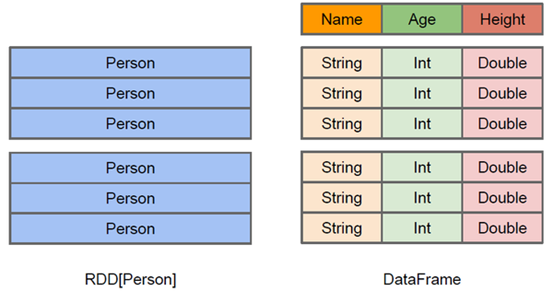SparkSql学习笔记(包含IDEA编写的本地代码)
Spark SQL and DataFrame
1.为什么要用Spark Sql
原来我们使用Hive,是将Hive Sql 转换成Map Reduce 然后提交到集群上去执行,大大简化了编写MapReduce的程序的复杂性,由于MapReduce这种计算模型执行效率比较慢,所以Spark Sql的应运而生,它是将SparkSql转换成RDD,然后提交到集群执行,执行效率非常的快。
Spark Sql的有点:1、易整合 2、统一的数据访问方式 3、兼容Hvie 4、标准的数据连接
2、DataFrames
什么是DataFrames?
与RDD类似,DataFrames也是一个分布式数据容器,然而DataFrame更像是传统数据库的二维表格,除了数据以外,还记录数据的结构信息,即schema。同时,与Hive类似,DataFrame与支持嵌套数据类型(struct、array和map)。从API的易用性上看,DataFrame API提供的是一套高层的关系操作,比函数式的RDD API要更加友好,门槛更低。由于与R和Pandas的DataFrame类似,Spark DataFrame很好地继承了传统单机数据分析的开发体验。

创建DataFrames
在Spark SQL中SQLContext是创建DataFrames和执行SQL的入口,在spark-1。5.2中已经内置了一个sqlContext。
1.在本地创建一个文件,有三列,分别是id、name、age,用空格分隔,然后上传到hdfs上
hdfs dfs -put person.txt /
2.在spark shell执行下面命令,读取数据,将每一行的数据使用列分隔符分割
val lineRDD = sc.textFile("hdfs://hadoop01:9000/person.txt").map(_.split(" "))
3.定义case class(相当于表的schema)
case class Person(id:Int, name:String, age:Int)
4.将RDD和case class关联
val personRDD = lineRDD.map(x => Person(x(0).toInt, x(1), x(2).toInt))
5.将RDD转换成DataFrame
val personDF = personRDD.toDF
6.对DataFrame进行处理
personDF.show
代码:
object SparkSqlTest { def main(args: Array[String]): Unit = { val conf = new SparkConf().setMaster("local").setAppName("SQL-1") val sc = new SparkContext(conf) fun1(sc) } //定义case class 相当于表的schema case class Person(id:Int,name:String,age:Int) def fun1(sc:SparkContext): Unit ={ val sqlContext = new SQLContext(sc)
// 位置一般情况下是换成HDFS文件路径 val lineRdd = sc.textFile("D:\\data\\person.txt").map(_.split(" ")) val personRdd = lineRdd.map(x=>Person(x(0).toInt,x(1),x(2).toInt)) import sqlContext.implicits._ val personDF = personRdd.toDF //注册表 personDF.registerTempTable("person_df") //传入sql val df = sqlContext.sql("select * from person_df order by age desc") //将结果以JSON的方式存储到指定位置 df.write.json("D:\\data\\personOut") sc.stop() }
DataFrame 常用操作
DSL风格语法(个人理解短小精悍的含义)
// 查看DataFrame部分列中的内容 df.select(personDF.col("name")).show() df.select(col = "age").show() df.select("id").show() // 打印DataFrame的Schema信息 df.printSchema() //查询所有的name 和 age ,并将 age+2 df.select(df("id"),df("name"),df("age")+2).show() //查询所有年龄大于20的 df.filter(df("age")>20).show() // 按年龄分组并统计相同年龄人数 df.groupBy("age").count().show()
SQL风格语法(前提:需要将DataFrame注册成表)
//注册成表 personDF.registerTempTable("person_df") // 查询年龄最大的两位 并用对象接接收 val persons = sqlContext.sql("select * from person_df order by age desc limit 2") persons.foreach(x=>print(x(0),x(1),x(2)))
通过StructType直接指定Schema
1 /*通过StructType直接指定Schema*/ 2 def fun2(sc: SparkContext): Unit = { 3 val sqlContext = new SQLContext(sc) 4 val personRDD = sc.textFile("D:\\data\\person.txt").map(_.split(" ")) 5 // 通过StructType直接指定每个字段的Schema 6 val schema = StructType(List(StructField("id", IntegerType, true), StructField("name", StringType, true), StructField("age", IntegerType))) 7 //将rdd映射到RowRDD 8 val rowRdd = personRDD.map(x=>Row(x(0).toInt,x(1).trim,x(2).toInt)) 9 //将schema信息应用到rowRdd上 10 val dataFrame = sqlContext.createDataFrame(rowRdd,schema) 11 //注册 12 dataFrame.registerTempTable("person_struct") 13 14 sqlContext.sql("select * from person_struct").show() 15 16 sc.stop() 17 18 }
连接数据源
1 /*连接mysql数据源*/ 2 def fun3(sc:SparkContext): Unit ={ 3 val sqlContext = new SQLContext(sc) 4 val jdbcDF = sqlContext.read.format("jdbc").options(Map("url"->"jdbc:mysql://192.168.180.100:3306/bigdata","driver"->"com.mysql.jdbc.Driver","dbtable"->"person","user"->"root","password"->"123456")).load() 5 jdbcDF.show() 6 sc.stop() 7 }
再回写到数据库中
1 // 写入数据库 2 val personTextRdd = sc.textFile("D:\\data\\person.txt").map(_.split(" ")).map(x=>Row(x(0).toInt,x(1),x(2).toInt)) 3 4 val schema = StructType(List(StructField("id", IntegerType), StructField("name", StringType), StructField("age", IntegerType))) 5 6 val personDataFrame = sqlContext.createDataFrame(personTextRdd,schema) 7 8 val prop = new Properties() 9 prop.put("user","root") 10 prop.put("password","123456") 11 //写入数据库 12 personDataFrame.write.mode("append").jdbc("jdbc:mysql://192.168.180.100:3306/bigdata","bigdata.person",prop) 13 14 sc.stop()




 浙公网安备 33010602011771号
浙公网安备 33010602011771号